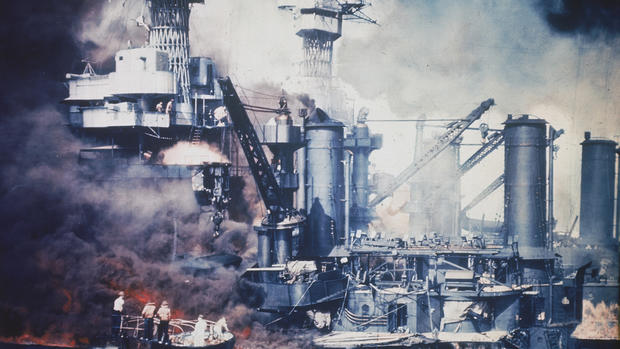Newly-published report of Pearl Harbor attack
"It would be well, perhaps, to review the events of the past seven days and not minimize the horror, to better prepare for what may come again."
So wrote Elizabeth McIntosh, a newspaper reporter for the Honolulu Star-Bulletin, who covered the attack on Pearl Harbor and the surrounding community on December 7, 1941, and on the subsequent week as a climate of war gripped Hawaii.
McIntosh's editors, however, believed the graphic content of her account would be too upsetting and chose not to run the article. Now, on the 71st anniversary of the surprise attack that pulled America into the war, the Washington Post has published McIntosh's account for the first time, along with an interview with the journalist and author, now 97.
McIntosh - who later worked for the Office of Strategic Services and Central Intelligence Agency - is now retired and a resident of Prince William County, Va.
She told the Post's Brook Silva-Braga she had been assigned by the editor to write "from the women's point of view."
"It was kind of hard to do, because I couldn't figure out why the women would be any different from the men," she told Silva-Braga.
"For seven ghastly, confused days, we have been at war. To the women of Hawaii, it has meant a total disruption of home life, a sudden acclimation to blackout nights, terrifying rumors, fear of the unknown as planes drone overhead and lorries shriek through the streets.The seven days may stretch to seven years, and the women of Hawaii will have to accept a new routine of living. It is time, now, after the initial confusion and terror have subsided, to sum up the events of the past week, to make plans for the future. ...
McIntosh wrote of seeing war plane fall into the Pacific Ocean, of anti-aircraft gunsmoke dotting the sky, or buildings being shattered as bombs whistled overhead.
"For the first time, I felt that numb terror that all of London has known for months. It is the terror of not being able to do anything but fall on your stomach and hope the bomb won't land on you. It's the helplessness and terror of sudden visions of a ripping sensation in your back, shrapnel coursing through your chest, total blackness, maybe death."
McIntosh was assigned to cover the emergency room, where the wounded and the dead were brought by blood-soaked ambulance drivers as bombs continued to fall and windows were taped to prevent their shattering. "I had never known that blood could be so bright red," she wrote. She saw contorted bodies laid on slabs in the morgue.
"Fear contorted their faces. Their clothes were blue-black from incendiary bombs. One little girl in a red sweater, barefoot, still clutched a piece of jump-rope in her hand."
McIntosh noted the efficiency of first responders who had applied tetanus shots - and marked those receiving them with a red T on their foreheads.
Her account also tells of the fear in Honolulu, as she saw streets where stores had been bombed and completely burned down. Sirens pierced the city throughout the night, and on Monday residents would be startled whenever planes roared overhead. Rumors spread of invasion, poisoned food.
Evacuees from Hickam Air Force Base told McIntosh of having missed being strafed by machine gun bullets. A child told of her father being killed.
She also wrote of the organization she saw on Hawaii at Red Cross centers, canteens, evacuee districts - "mapped out thoughtfully and competently by women who have had experience in World War I, who have looked ahead and foreseen the carnage of the past seven days and planned."
